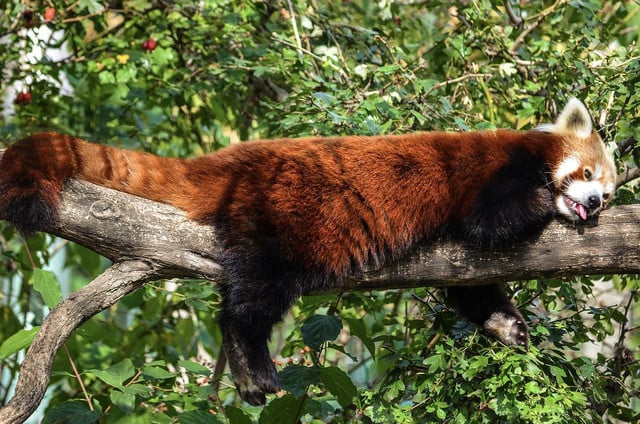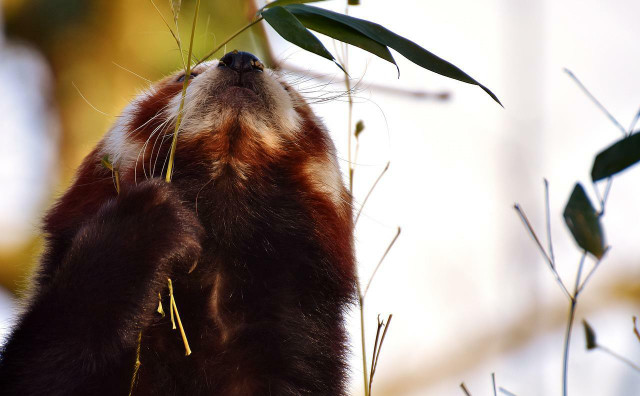Why are red pandas endangered? The short answer is, humanity. This article seeks to better understand why red pandas are endangered and how we can help.
Known for their sweet, kitten-like faces, beautiful red coats, and fluffy, ringed tails, red pandas are beautiful creatures. But did you know that red pandas are endangered?
Whether you’re an animal lover or an all-around lover of the planet, it’s important to stay up to date on the latest regarding endangered species. Everything is connected, especially when it comes to the effects of climate change.
Read further to understand why red pandas are endangered and how you can help.
What Are Red Pandas?

(Foto: CC0 / Pixabay / strichpunkt)
Red pandas are small, red-coated mammals native to the Himalayas. They are the only living members of the ancient species from the order Carnivora, superfamily Musteoloidea, and are actually not related to giant pandas at all. Just larger in size than a domestic cat, the closest living relatives of the red panda are actually likely to be members of the animal family which includes weasels, raccoons, and skunks.
Despite giant pandas having arguably gained greater fame, it is the red panda that was first classified in 1825 with its scientific name, Ailurus fulgens. Giant pandas were then classified later and given the panda name based on the bamboo eating characteristics that both mammal species shared.
While five million years ago their ancestors roamed North America, red pandas inhabit high-altitude temperate forests of the Eastern Himalayas and other mountains where bamboo grows. Their habitat spans some regions of China, Nepal, Bhutan, Myanmar, and Tibet.
The Nature of Red Pandas



(Foto: CC0 / Pixabay / Wildfaces)
To understand why red pandas are endangered and what we can do to help, it’s important to understand their characteristics. The red panda’s notorious fluffy tail assists with balance as these fur balls navigate rocky landscapes and trees. When they aren’t napping high in the forest canopy, they’re using their tails to maintain stability as they balance along the branches, and using their semi-retractable claws to move from tree to tree. They are agile creatures that trees for shelter, to avoid predators, and even to sunbathe in the winter.
The red panda doesn’t hibernate, so its thick fur and bushy tails – which they can wrap around their bodies for warmth – also aid in providing protection from harsh winter elements. They like to be near water and are most active from dusk until dawn. Like many mammals, they sleep most of the day. Their amber coat allows them to blend into the reddish-brown moss and white lichens that cover fir trees.
Hint: A big reason red pandas are endangered is related to their habitat.
Communication Among Red Pandas



(Foto: CC0 / Pixabay / Alexas_Fotos)
Red pandas are quite solitary creatures, except during mating season when it is not uncommon to see pairs moving together.
Red pandas are able to pass along information to others by urinating or rubbing the base of their tail to mark. The scent communicates helpful information about their fertility such as their sex and age. To mark their territory, red pandas have another set of scent glands between their footpads. There, they release a clear liquid that is odorless to humans.
In the Northern Hemisphere, breeding takes place between January and March, whereas in the Southern Hemisphere it is extended from June to August. Red panda babies are born in late spring to early summer, which coincides with the availability of the juiciest and tenderest bamboo shoots of the year. The babies stay with their mothers for about a year before taking off on their own. Red pandas can live to be up to 23 years old.
Diet



(Foto: CC0 / Pixabay / Alexas_Fotos)
Despite technically being carnivores, more than 95% of the red panda’s diet is bamboo. They can also eat fruit, roots, insects, eggs, and even small lizards. They’re finicky about the part of the bamboo plant they eat as they only consume the tips of the leaves – which contain more nutrients than the rest of the plant – and the appetizing bamboo shoots.
Why Are Red Pandas Endangered?



(Foto: CC0 / Pixabay / trilemedia)
Like most endangered species, red pandas are threatened due to a decrease in habitat. Their homes in the Himalayas are being deforested at alarming rates to be converted to logging sites, mines, and farmland to grow crops and allow cattle to graze.
Even when only small sections of forest are cleared, it has a deep impact on the surrounding environment. Because they rely on their nesting trees for safety, the destruction of small portions of forest disconnects groups of red pandas from one another, contributing to a decrease in diversity among populations and higher risks of poor health caused by inbreeding. When livestock are introduced to these areas and roam freely, they also compete for the bamboo with the red panda population. As their habitat shrinks, it becomes harder for red pandas to find enough bamboo to sustain themselves.
Additionally, red pandas can be harmed or killed unintentionally through trappings put out for other animals like deer and wild hogs. Dogs, used to protect livestock, sometimes attack red pandas when their paths cross. If the red pandas survive the attack, dogs can still transmit life-threatening illnesses such as canine distemper and rabies.
Other Threats to Red Pandas



(Foto: CC0 / Pixabay / Pfüderi)
The red panda also faces threats from hunting and poaching. The attractive fur of the red panda has traditionally been used by some rural and local communities who wear the pelts on special occasions and for good luck. While this practice is now illegal, some people still attempt to carry on this tradition.
Red panda fur and meat are also coveted in some medicinal practices. This also heightens the incentive for hunters and poachers who are able to make a profit from this demand.
Some hunters even capture red pandas to sell them as illegal pets. It goes without saying that keeping red pandas as a pet is a poor idea not only because it contributes to the endangerment of these populations, but also because these are wild creatures that have not been domesticated and thus, would not thrive in a captive environment without specific, expert care and a specialized diet.
What You Can Do to Help



(Foto: CC0 / Pixabay / lshhweb)
In order to reverse these effects before the red pandas of the earth become extinct, we have to come together as a global community. Regions of the Himalayas are already targeting this problem by passing laws to conserve forests and put a stop to poaching.
According to the International Union for Conservation and Nature (IUNC) about 41-50 percent of red pandas are protected through legally protected areas in China and across the Himalayas.
With increased public attention directed towards the endangerment of red pandas, it is possible to increase pressure on governments to protect more areas and increase vigilance. As awareness spreads, there are more organizations such as The Red Panda Network which seek to incentivize and inspire environmental stewardship and education among local populations to aid in the recovery of the endangered red panda populations.
You can personally make a difference by spreading awareness, donating or fundraising, taking part in ecotourism, and speaking out against the red panda trade. You can even virtually adopt a red panda through the World Wild Life website. Perhaps most importantly, be sure to always source consumer goods from companies that do not contribute to deforestation and that are fair trade.
Read More:
- Speciesism: What Does It Mean and How Can We Prevent It?
- What Is a Bioregion And Which Ones Are There?
- Eco-Anxiety: Climate Change Stress and How to Cope
Do you like this post?









